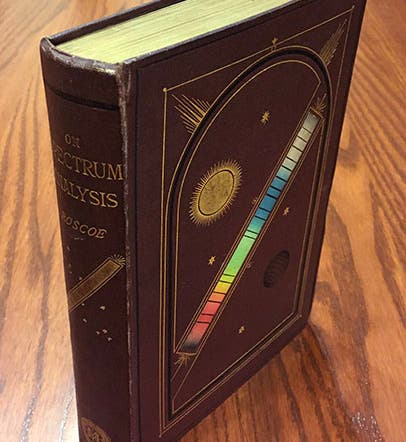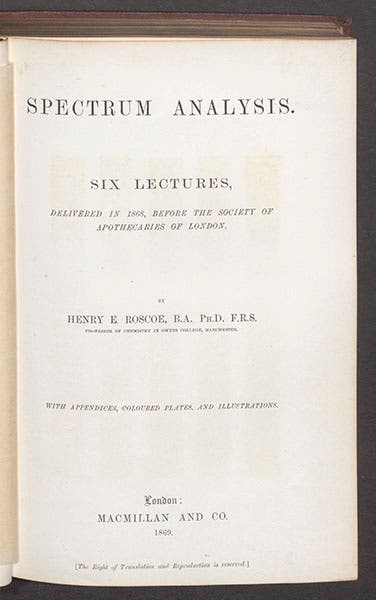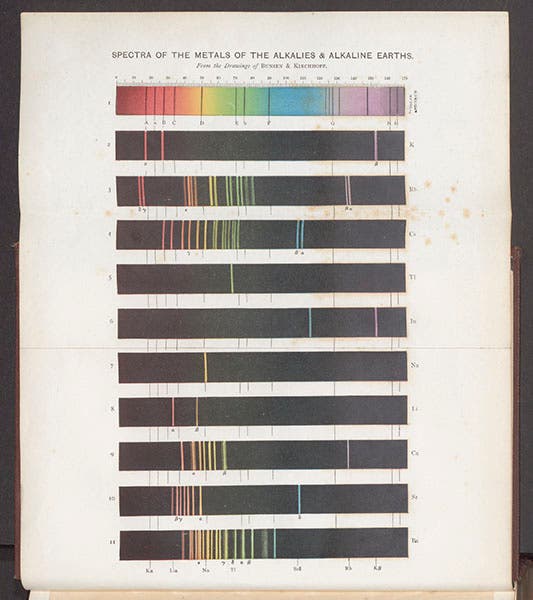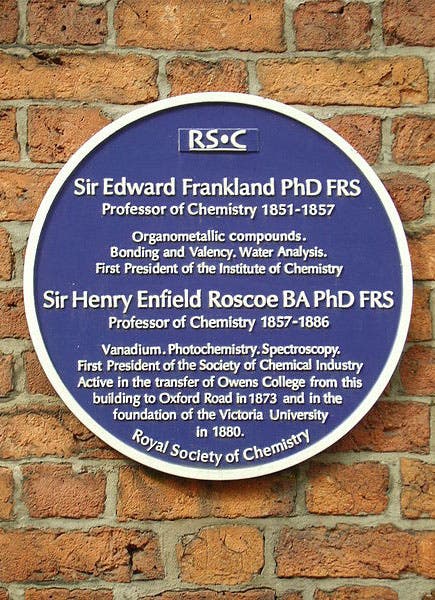Scientist of the Day - Henry Enfield Roscoe
Henry Enfield Roscoe, an English chemist, died Dec. 18, 1915, at the age of 81. Roscoe studied with Robert Bunsen in Heidelberg in the mid-1850s, in the heady days when Bunsen and Gustav Kirchhoff were beginning their investigations of chemical spectra. When Roscoe took up the position of Professor of Chemistry at Manchester in 1857, succeeding Edward Frankland, he retained close ties with Bunsen, honoring his mentor by translating Bunsen's major work on gas analysis, Gasometrischen Methoden (1857), into English as Gasometry : Comprising the Leading Physical and Chemical Properties of Gases, coming out with the translation in the same year as Bunsen's German original.
When, several years later, Bunsen and Kirchhoff announced the results of their investigations into chemical spectra, and revealed that the dark lines in the solar spectrum were optical signatures that revealed the chemical make-up of the Sun, Roscoe took the initiative and translated that work into English as well, publishing it as Researches on the Solar Spectrum, and the Spectra of the Chemical Elements (1862-63). The Kirchhoff/Bunsen discovery was a milestone of 19th-century science, launching simultaneously the new fields of spectroscopy, photochemistry, and astrophysics, and the rapid reception of these sciences in England was almost entirely due to Roscoe. We have both of these translations by Roscoe in our History of Science Collection.
Roscoe was also a great popularizer of spectroscopy. In 1868, he was asked to give a series of lectures on the new sciences to the Society of Apothecaries of London. The lectures were published the next year as Spectrum Analysis: Six Lectures, and they were enormously popular, necessitating a second edition in 1870. We have both of these editions, and four of our images here were drawn from the first edition of this book. Perhaps one reason for the book's popularity was its beautiful, spectrally-embossed cover (first image). Other images show a Kirchhoff-Bunsen comparison between the solar spectrum and the spectra of 10 metals (fourth image), and William Huggins' map of metallic lines (fifth image).
When I was young and ignorant, I used to show the famous group portrait of Kirchhoff and Bunsen (second image) to my history of science survey class and say something like "Kirchhoff is standing at the left, Bunsen, who was very tall, is seated in the center, and the gentleman at the right was just lucky to be in the photograph." I didn't even know who Roscoe was, and I did him a great injustice with my flip remark. Without Roscoe, spectroscopy would probably have taken much longer to make it into the English chemical curriculum. Without Roscoe, England's great spectrographic astronomer, William Huggins, might have chosen another astronomical path to occupy his attention. Without Roscoe, it is almost certain that Henry Draper of the United States would not have become fascinated with the spectra of the stars, and who knows then who would have funded Harvard’s massive stellar classification project of the 1890s and beyond. Roscoe well deserves his place in the photograph with Kirchhoff and Bunsen.
English chemists appreciate Roscoe, even if I, for a long time, did not. He has a blue plaque at the University of Manchester, which he shares with Frankland (sixth image). The two were jointly responsible for making Manchester a major center for chemical and physical studies at the end of the 19th century.
Dr. William B. Ashworth, Jr., Consultant for the History of Science, Linda Hall Library and Associate Professor emeritus, Department of History, University of Missouri-Kansas City. Comments or corrections are welcome; please direct to ashworthw@umkc.edu.









![“Aurora Borealis,” hand-colored wood engraving by Josiah Wood Whymper, [Natural Phenomena], plate 2, 1846 (Linda Hall Library)](https://assets-us-01.kc-usercontent.com:443/9dd25524-761a-000d-d79f-86a5086d4774/0245ffcb-b70c-477c-8792-0a73ebd54eb2/Whymper%2011.jpg?w=210&h=210&auto=format&fit=crop)

